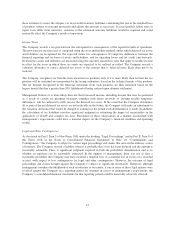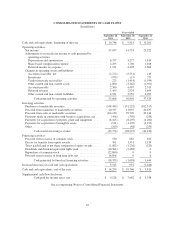Apple 2013 Annual Report Download - page 42
Download and view the complete annual report
Please find page 42 of the 2013 Apple annual report below. You can navigate through the pages in the report by either clicking on the pages listed below, or by using the keyword search tool below to find specific information within the annual report.impact the Company’s net income only when such securities are sold or an other-than-temporary impairment is
recognized. Realized gains and losses on the sale of securities are determined by specific identification of each
security’s cost basis. The Company regularly reviews its investment portfolio to determine if any security is
other-than-temporarily impaired, which would require the Company to record an impairment charge in the period
any such determination is made. In making this judgment, the Company evaluates, among other things, the
duration and extent to which the fair value of a security is less than its cost; the financial condition of the issuer
and any changes thereto; and the Company’s intent to sell, or whether it will more likely than not be required to
sell, the security before recovery of its amortized cost basis. The Company’s assessment on whether a security is
other-than-temporarily impaired could change in the future due to new developments or changes in assumptions
related to any particular security.
Inventory Valuation and Valuation of Manufacturing-Related Assets and Estimated Purchase Commitment
Cancellation Fees
The Company must order components for its products and build inventory in advance of product shipments and
has invested in manufacturing process equipment, including capital assets held at its suppliers’ facilities. In
addition, the Company has made prepayments to certain of its suppliers associated with long-term supply
agreements to secure supply of inventory components. The Company records a write-down for inventories of
components and products, including third-party products held for resale, which have become obsolete or are in
excess of anticipated demand or net realizable value. The Company performs a detailed review of inventory that
considers multiple factors including demand forecasts, product life cycle status, product development plans,
current sales levels, and component cost trends. The Company also reviews its manufacturing-related capital
assets and inventory prepayments for impairment whenever events or circumstances indicate the carrying amount
of such assets may not be recoverable. If the Company determines that an asset is not recoverable, it records an
impairment loss equal to the amount by which the carrying value of such an asset exceeds its fair value.
The industries in which the Company competes are subject to a rapid and unpredictable pace of product and
component obsolescence and demand changes. In certain circumstances the Company may be required to record
additional write-downs of inventory, inventory prepayments and/or manufacturing-related capital assets. These
circumstances include future demand or market conditions for the Company’s products being less favorable than
forecasted, unforeseen technological changes or changes to the Company’s product development plans that
negatively impact the utility of any of these assets, or significant deterioration in the financial condition of one or
more of the Company’s suppliers that hold any of the Company’s manufacturing process equipment or to whom
the Company has made an inventory prepayment. Such write-downs would adversely affect the Company’s
results of operations in the period when the write-downs were recorded.
The Company records accruals for estimated cancellation fees related to component orders that have been
cancelled or are expected to be cancelled. Consistent with industry practice, the Company acquires components
through a combination of purchase orders, supplier contracts, and open orders in each case based on projected
demand. Where appropriate, the purchases are applied to inventory component prepayments that are outstanding
with the respective supplier. Purchase commitments typically cover the Company’s forecasted component and
manufacturing requirements for periods up to 150 days. If there is an abrupt and substantial decline in demand
for one or more of the Company’s products, if the Company’s product development plans change, or if there is an
unanticipated change in technological requirements for any of the Company’s products, then the Company may
be required to record additional accruals for cancellation fees that would adversely affect its results of operations
in the period when the cancellation fees are identified and recorded.
Warranty Costs
The Company provides for the estimated cost of warranties at the time the related revenue is recognized based on
historical and projected warranty claim rates, historical and projected cost-per-claim, and knowledge of specific
product failures that are outside of the Company’s typical experience. Each quarter, the Company reevaluates
40
























